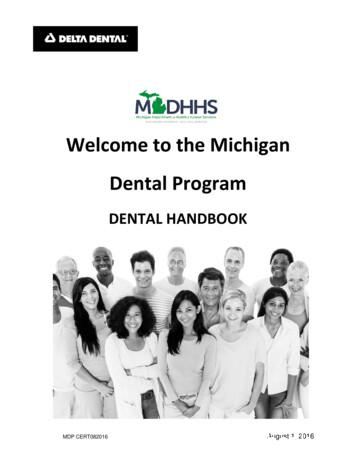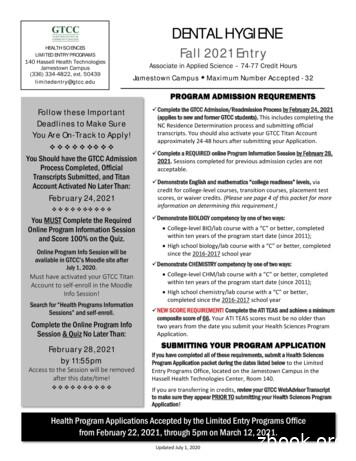Dental Material Filling Materials
DENTAL MATERIALFILLING MATERIALSLecture 16Loss of tooth structure by dental caries (fig. A), trauma (fig. B) or abrasion (fig.C) can be replaced by filling material but it is veryimportant to know that there is no single filling material could be used as a substitute for all cases because in some cases thestrength & abrasion resistance are more important than appearance while appearance would be more important than strengthin other cases. (Because there is no ideal material)ABCRequirements of an ideal Filling material:1. Should be dimensionally stable, no contraction or expansion occurs after use.2. Should have good abrasion resistance & compression and tensile strength.3. Coefficient of thermal expansion of the filling should be similar to those of enamel and dentine.4. Should adhere well to the tooth walls and seal the margin prevent ingress (entrance) of fluid and bacteria.5. Should have the same color of the natural teeth, also should not change color by time.6. Should be bacteriostatic and anti-cariogenic and easily polished.7. Should be harmless to the patient and to the dentist and should not be irritant to dental pulp and soft tissue.8. Should withstand large variation in PH and a variety of solvents which may be taken into mouth.9. Should be good thermal insulator; protecting the dental pulp from the harmful effect of the hot and cold stimuli.10.Metallic material should not undergo excessive corrosion11. Should not be involved in the development of electrical currents which may cause galvanic pain.12.Working time should be sufficiently long, to enable manipulation and placement of material before setting. But settingtime should not so long for comfort of patient.Classification of Filling materials1- Non-metallic.A. Polymeric: unfilled(acrylic) and filled (composite)B. non-polymeric (glass inomer cement and Silicate cement)2- Metalic (Amalgam and Gold).
Silicate cement filling material:Filling material for anterior teeth, supplied as a powder and liquid of phosphoric acid, not used nowadays because:1- Low PH (5 - 3.5) of phosphoric acid cause Pulp irritation.2- Week mechanical properties.3- Shrinkage on setting.4- High solubility and disintegrate in the mouth.Acrylic resin:At 1930 silicate was neglected due to development of acrylic .The unfilled acrylic materials composed of powder (Polymethylmethacrylate, initiator) and liquid (methyl methacrylate, activator). It has good resistance to solubility.The undesirable qualities of unfilled acrylics were: Discolouration and Porosity. Large dimensional change on setting high coefficient of thermal expansion and contraction Percolation of saliva at margins. Low mechanical strength. Low resistance to wear and problems with recurrent caries. Eugenol lining material inhibits the polymerization reaction.CompositeComposite refers to compound of two or more different materials with properties that are superior or intermediate to those ofthe individual constituents. Composite filling is polymeric filling material reinforced with filler particles. It was developed toovercome the disadvantages of acrylic filling and of silicate cement. It is most popular anterior filling material. Now days,composite are used as anterior and posterior filling materials.Composite is used as:1. Anterior restorations2. Posterior restorationsComposite is not used in the following cases:1. Large posterior restorations (composite fillings are not strong enough to withstand forces of mastication)2. Bruxism (composite fillings are not strong enough to withstand such force)3. Poor isolation (composite can’t adhere well to tooth structure if there is saliva)Advantages of composite1. Esthetics2. Conservation of tooth structure3. Adhesion to tooth structure4. Low thermal conductivity
5. Substitute to amalgamDisadvantages of composite1. Technique sensitivity (excellent isolation to the tooth)2. Polymerization shrinkage that cause:a- marginal leakageb- secondary cariesc- post-operative sensitivity3. Decreased wear resistanceComposition of composite:The essential components of a composite are:1- Resin matrix (binder)2- Filler (Quartz, colloidal silica or heavy metals glasses)3- Coupling agent (organo silanes)Resin matrix:A blend of monomers & their properties are superior to the properties of acrylic resins.Filler particles:Addition of filler particles into resin matrix improves its properties by:1- Improves mechanical properties like strength and hardness and abrasion resistance.2- Reduced water sorption and coefficient of thermal expansion3- The amount of resin in the composite is less, so the curing shrinkage is reduced, so marginal leakage is reduced as well.4- Radiopaque.Types of filler:1- Quartz filler: They are obtained by grinding the quartz. They are mainly used in conventional composites. They are chemicallyinert and very hard & this makes the restoration more difficult to polish and can cause abrasion of opposing teeth andrestoration.2- Colloidal silica: they’re micro fillers. They are added in small amount (5 wt%) to modify the viscosity of the composite.Colloidal silica particles have large surface area thus even small amount of micro fillers thickens the resin.3- glasses / ceramic containing heavy metal:- These fillers provide radiopacity to resin restoration.Filler Particles size and distribution:If a single particle size is used, a space will exist between particles so particles of different sizes are added so that the smallerparticles can then fill up these spaces.Coupling agents: Coupling agents bond the filler particles to the resin matrix. This allows the more plastic resin matrix totransfer stress to stiffer filler particles. Most commonly used coupling agent is Organo silane.Function of coupling agents:l - They improve the physical and mechanical properties of resin.2- They prevent water from penetrating the filler - resin interface.3- Prevent the filler from being dislodged from the resin matrix.
Types of composite:A) Based on curing mechanism:1 - Chemically activated composite2- Light activated compositeB) Based on size of filler particles:1 - Conventional composite2- Small particles composite3-Micro filled composite4- Hybrid composite1- Chemically activated, composite resins:This is two - paste system:1- Base paste : Contains benzoyl peroxide initiator2- Catalyst paste : Tertiary amine activatorSetting: When two pastes are spatulated the amine reacts with the benzoyl peroxide to form free radical which starts thepolymerization.2-Light activated composite resins:They are widely used than the chemically activated resins ; these are single paste system containing Photo initiator.SettingUnder normal light they don’t interact. However, when exposed to light of the correct wave length the photo initiator isactivated. The photo initiator has an absorption range of light between 400 and 800 nm. This is in the blue region of visible lightspectrum & this is why the blue light is used in the clinic.Comparison of light activated and chemically activated resinsLight activatedChemical activatedRequired light of correct wave Length for Activated by peroxide-amine systemits activationCure only where sufficient Intensity of light Cures when the two pastes are mixedis receivedtogetherWorking time under control of Operatorworking time is limited because it starts asthe two pastes are mixedSupplied as single component in Light tight supplied as two paste systemsyringesLess chance of air entrapment during Air may get incorporated during mixingmanipulationresulting in reduction of properties.Classification of composite based on size of filler particles: -Conventional composite (Traditional or macro filled composite): Quartz is most commonly used as filler. Average size is 8 I2μm.disadvantages:1. Polishing is difficult and results in a rough surface; this is because when we polish the filling, wear of the softer resinmatrix will take place leaving the hard filler particles elevated.2. Tendency to discolour because the rough surface tends to stain.2- Micro filled composite:They were developed to overcome the problems of surface roughness of conventional composite.
Colloidal silica is used as micro filler and its surface area is large so only small amount of silica is used.Their mechanical properties are inferior to other type? This is because of their higher resin content.Their biggest advantages-is their esthetics. The micro filled composite is the resin of choice for esthetics restoration ofanterior teeth especially when strength is not required.3- Small Particles composite:Small particles composite were introduced in an attempt to have good surface smoothness (Like micro filled composite) and thephysical and mechanical properties of conventional composite. This type of composite use fillers that have been ground tosmaller size. Due to the higher filler content, the best physical and mechanical properties are observed with this type. Heavymetal glasses are used here.4-Hybrid compositeThese are developed so as to obtain better surface smoothness than that of small particle and also maintain the properties ofsmall particle composite.The hybrid composites are widely used for anterior filling where esthetic is required & for posterior filling where strength isrequired.
Types of composite: A) Based on curing mechanism: 1- Chemically activated composite 2- Light activated composite B) Based on size of filler particles: 1 - Conventional composite 2- Small particles composite 3-Micro filled composite 4- Hybrid composite 1- Chemically activated, composite resins: This is two - paste system:
DENTAL SCIENCES 1 Chapter 1 I Dental Assisting— The Profession 3 The Career of Dental Assisting 4 Employment for the Dental Assistant 4 The Dental Team 6 Dental Jurisprudence and Ethics 12 Dental Practice Act 12 State Board of Dentistry 12 The Dentist, the Dental Assistant, and the Law 13 Standard of Care 13 Dental Records 14 Ethics 14
Cigna Dental Care DMO Patient Charge Schedules 887394 09/15 CDT 2016 Covered under Procedure Code1 Dental Description and Nomenclature Cigna Dental 01 and 02 PCS Cigna Dental 03 PCS Cigna Dental 04 PCS Cigna Dental 05 PCS Cigna Dental 06 PCS Cigna Dental 07 PCS Cigna Dental 08 PCS Chair Time Per Y/N Minutes Code # (if different) Y/N Code # (if .
is a detailed list of dental services provided by a dental office and given to Delta Dental for payment. Delta Dental means Delta Dental Plan of Michigan, Inc., a service provider for dental benefits under the Michigan Dental Program. Delta Dental ID Card is a permanent (not monthly) card. We send
Mid-level dental providers, variously referred to as dental therapists, dental health aide therapists and registered or licensed dental practitioners, work as part of the dental team to provide preventive and routine dental services, such as cleanings and fillings. Similar to how nurse practitioners work alongside physicians, mid-level dental .
Jun 14, 2016 · active duty Soldiers treated at any of five dental clinics on Fort Bragg. These clinics included Davis Dental Clinic, Joel Dental Clinic, LaFlamme Dental Clinic, Pope Dental Clinic, and Smoke Bomb Hill Dental Clinic. For each appointment the appointment type, date, and dental wellness class
DEN 131 Dental Hygiene Clinic 1 3 credits . Summer 2022. DEN 125 Dental Office Emergencies 1 credit DEN 140 Dental Hygiene Theory 2 1 credit DEN 141 Dental Hygiene Clinic 2 2 credits DEN 222 General and Oral Pathology 2 credits . Fall 2022. DEN 123 Nutrition/Dental Health 2 credits DEN 220 Dental Hygiene Theory 3 2 credits DEN 221 Dental .
Dental Blue for Individuals. SM - a consumer-driven dental plan for individuals and their eligible dependents . Dental Blue for Seniors. SM - a consumer dental product for individuals and their spouse age 65 and older . Dental Blue For Federal Employee Program - offers federal employees a dental supplemental plan to
Implants. According to the Dental Implant Cost Guide a single Mini Dental Implant costs, on average, about 1000. That's less than half the cost of a single traditional Dental Implant. Mini Dental Implants are a single unit, with a ball, or adaptor, on top. Dentures fit right onto Mini Dental Implants. BEST DENTAL ASSOCIATES / DRSTONEDDS.COM























